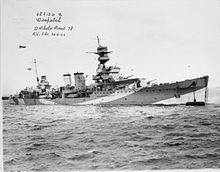Name HMS Despatch Laid down 8 July 1918 Launched 24 September 1919 | Ordered March 1918 Commissioned 2 June 1922 Construction started 8 July 1918 Length 144 m | |
 | ||
Fate Sold for scrap, 5 April 1946 | ||
HMS Despatch was a Danae-class light cruiser built for the Royal Navy during World War I. She was part of the Delhi sub-class of the Danae class.
Contents
Design and description
The Delhi sub-class was identical with the preceding ships except that their bows were raised for better seakeeping. The ships were 472 feet 6 inches (144.0 m) long overall, with a beam of 46 feet 9 inches (14.2 m) and a mean deep draught of 16 feet 11 inches (5.2 m). Displacement was 4,970 long tons (5,050 t) at normal and 5,250 long tons (5,330 t) at deep load. Despatch was powered by two Brown-Curtis steam turbines, each driving one propeller shaft, which produced a total of 40,000 indicated horsepower (30,000 kW). The turbines used steam generated by six Yarrow boilers which gave her a speed of about 29 knots (54 km/h; 33 mph). She carried 1,050 long tons (1,067 t) tons of fuel oil. The ship had a crew of about 450 officers and other ranks.
Despatch was armed with six centreline BL 6-inch (152 mm) Mk XII guns. One superfiring pair of guns was forward of the bridge, another pair were fore and aft of the two funnels and the last two were in the stern, with one gun superfiring over the rearmost gun. The two QF 4 inch Mk V naval gun anti-aircraft guns were positioned on elevated platforms between the funnels and the QF 2-pounder "pom-pom" AA guns were amidships on the upper deck. The ships were equipped with a dozen 21 in (533 mm) torpedo tubes in four triple mounts, two on each broadside.
Construction and career
She was laid down by Fairfield Shipbuilding and Engineering Company on 8 July 1918, launched on 24 September 1919, towed to Chatham Dockyard, and completed there on 15 June 1922.
Despatch had a relatively quiet wartime career, compared to her sisters. She was operating in the South Atlantic for the early part of the war, where she captured the German freighter SS Düsseldorf and intercepted the German merchant ship Troja. The crew of Troja scuttled her, however, before the ship could be captured. She was in the Mediterranean, escorting convoys in late 1940, and became involved in Operation White and the Battle of Cape Spartivento. By the battle of Cape Spartivento as part of Force "B", a sub-unit of Force "H", Gibraltar.
Despatch was present at the Normandy landings in June 1944 under the command of Commander R.T. White D.S.O.** (later Captain R.T. White D.S.O.**, 2nd son of Sir Archibald White, Bt. of Wallingwells). She was the headquarters ship for the Mulberry harbours. Whilst at Mulberry 'B' Despatch was present for the visit of H.M. King George VI. For her HQ Ship role, Despatch had had all its original guns removed and replaced with Anti-Aircraft batteries manned by army personnel to support its role as “Traffic Control” in building the Mulberry Harbour at Arromanches. Commander White was allocated landing pass “number one” for Arromanches.
Despatch was reduced to reserve in January 1945, and sold on 5 April 1946 for scrapping. She arrived at the yards of Arnott Young, of Troon, Scotland on 5 May 1946 to be broken up.
